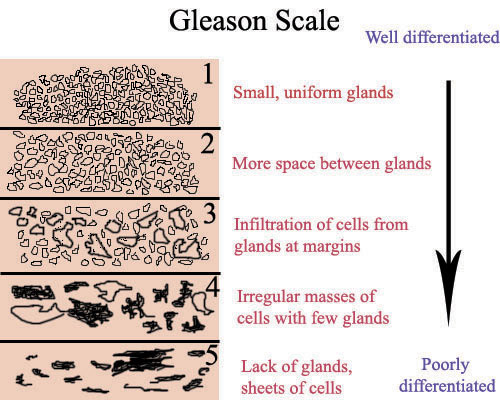Gleason score: Difference between revisions
No edit summary |
No edit summary |
||
| Line 1: | Line 1: | ||
[[Image:Gleasonscore2.jpg|thumb|300px|right|'''Gleason score''' Lower scores are associated with small, closely packed glands. Cells spread out and lose glandular architecture as score increases]] | [[Image:Gleasonscore2.jpg|thumb|300px|right|'''Gleason score''' Lower scores are associated with small, closely packed glands. Cells spread out and lose glandular architecture as score increases]] | ||
{{Search infobox}} | |||
{{SCC}} | |||
{{Editor Join}} | |||
==Overview== | |||
A '''Gleason score''' is given to [[prostate cancer]] based upon its [[microscopic]] appearance. The Gleason score is important because higher Gleason scores are associated with worse [[prognosis]]. This is because higher Gleason scores are given to cancer which is more aggressive. To assign a Gleason score, a piece of prostatic [[biological tissue|tissue]] must be obtained (a [[biopsy]]). This is done either by removing the gland ([[prostatectomy]]) or by sampling the [[gland]] with a [[hypodermic needle|needle]] introduced through the [[rectum]]. | A '''Gleason score''' is given to [[prostate cancer]] based upon its [[microscopic]] appearance. The Gleason score is important because higher Gleason scores are associated with worse [[prognosis]]. This is because higher Gleason scores are given to cancer which is more aggressive. To assign a Gleason score, a piece of prostatic [[biological tissue|tissue]] must be obtained (a [[biopsy]]). This is done either by removing the gland ([[prostatectomy]]) or by sampling the [[gland]] with a [[hypodermic needle|needle]] introduced through the [[rectum]]. | ||
Revision as of 18:30, 19 January 2009

Template:Search infobox Steven C. Campbell, M.D., Ph.D.
Please Join in Editing This Page and Apply to be an Editor-In-Chief for this topic: There can be one or more than one Editor-In-Chief. You may also apply to be an Associate Editor-In-Chief of one of the subtopics below. Please mail us [1] to indicate your interest in serving either as an Editor-In-Chief of the entire topic or as an Associate Editor-In-Chief for a subtopic. Please be sure to attach your CV and or biographical sketch.
Overview
A Gleason score is given to prostate cancer based upon its microscopic appearance. The Gleason score is important because higher Gleason scores are associated with worse prognosis. This is because higher Gleason scores are given to cancer which is more aggressive. To assign a Gleason score, a piece of prostatic tissue must be obtained (a biopsy). This is done either by removing the gland (prostatectomy) or by sampling the gland with a needle introduced through the rectum.
The Gleason score ranges from two to ten. A Gleason score of two is associated with the best prognosis and a score of ten with the worst. The final score is a combination of two different scores which each range from one to five. Gleason scores are associated with the following features:
- Grade 1 - The cancerous prostate closely resembles normal prostate tissue. The glands are small, well-formed, and closely packed
- Grade 2 - The tissue still has well-formed glands, but they are larger and have more tissue between them.
- Grade 3 - The tissue still has recognizable glands, but the cells are darker. At high magnification, some of these cells have left the glands and are beginning to invade the surrounding tissue.
- Grade 4 - The tissue has few recognizable glands. Many cells are invading the surrounding tissue
- Grade 5 - The tissue does not have recognizable glands. There are often just sheets of cells throughout the surrounding tissue.
A pathologist examines the biopsy specimen and attempts to give a score to the two patterns. First called the primary grade, represents the majority of tumor (has to be greater than 50% of the total pattern seen). Second - a secondary grade - relates to the minority of the tumor (has to be less than 50%, but at least 5%, of the pattern of the total cancer observed). These scores are then added to obtain the final Gleason score. For example, a prostate biopsy specimen may exhibit two different patterns, one which is assigned a number two and the other a number three. The final Gleason score in this case would be five.
The Gleason score is used to help evaluate the prognosis of men with prostate cancer. Together with other parameters, the Gleason score is incorporated into a strategy of prostate cancer staging which predicts prognosis and helps guide therapy.
The scoring system is named after Donald F. Gleason, M.D., a pathologist at the Minneapolis Veterans Affairs Hospital who developed it with other colleagues at that facility in the 1960s. [1] It remains an important tool.
References
- Gleason DF. The Veteran's Administration Cooperative Urologic Research Group: histologic grading and clinical staging of prostatic carcinoma. In Tannenbaum M (ed.) Urologic Pathology: The Prostate. Lea and Febiger, Philadelphia, 1977; 171-198.